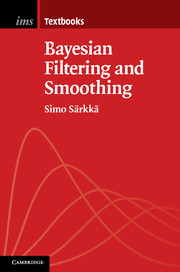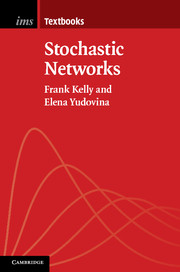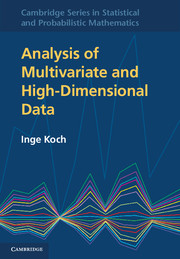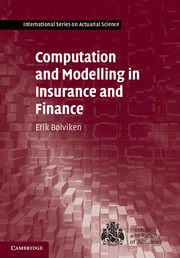Refine search
Actions for selected content:
2703 results in General statistics and probability
6 - Frequency and Severity Models
- from II - Predictive Modeling Foundations
-
-
- Book:
- Predictive Modeling Applications in Actuarial Science
- Published online:
- 05 August 2014
- Print publication:
- 28 July 2014, pp 138-164
-
- Chapter
- Export citation
Contents
-
- Book:
- Predictive Modeling Applications in Actuarial Science
- Published online:
- 05 August 2014
- Print publication:
- 28 July 2014, pp vii-xii
-
- Chapter
- Export citation
4 - Regression with Count-Dependent Variables
- from II - Predictive Modeling Foundations
-
-
- Book:
- Predictive Modeling Applications in Actuarial Science
- Published online:
- 05 August 2014
- Print publication:
- 28 July 2014, pp 87-106
-
- Chapter
- Export citation
Acknowledgments
-
- Book:
- Predictive Modeling Applications in Actuarial Science
- Published online:
- 05 August 2014
- Print publication:
- 28 July 2014, pp xix-xx
-
- Chapter
- Export citation
2 - Overview of Linear Models
- from II - Predictive Modeling Foundations
-
-
- Book:
- Predictive Modeling Applications in Actuarial Science
- Published online:
- 05 August 2014
- Print publication:
- 28 July 2014, pp 13-64
-
- Chapter
- Export citation
15 - Generalized Additive Models and Nonparametric Regression
- from III - Bayesian and Mixed Modeling
-
-
- Book:
- Predictive Modeling Applications in Actuarial Science
- Published online:
- 05 August 2014
- Print publication:
- 28 July 2014, pp 367-397
-
- Chapter
- Export citation
IV - Longitudinal Modeling
-
- Book:
- Predictive Modeling Applications in Actuarial Science
- Published online:
- 05 August 2014
- Print publication:
- 28 July 2014, pp 425-426
-
- Chapter
- Export citation
II - Predictive Modeling Foundations
-
- Book:
- Predictive Modeling Applications in Actuarial Science
- Published online:
- 05 August 2014
- Print publication:
- 28 July 2014, pp 11-12
-
- Chapter
- Export citation
10 - Fat-Tailed Regression Models
- from II - Predictive Modeling Methods
-
-
- Book:
- Predictive Modeling Applications in Actuarial Science
- Published online:
- 05 August 2014
- Print publication:
- 28 July 2014, pp 236-259
-
- Chapter
- Export citation
20 - Transition Modeling
- from IV - Longitudinal Modeling
-
-
- Book:
- Predictive Modeling Applications in Actuarial Science
- Published online:
- 05 August 2014
- Print publication:
- 28 July 2014, pp 515-538
-
- Chapter
- Export citation

Bayesian Filtering and Smoothing
-
- Published online:
- 05 June 2014
- Print publication:
- 05 September 2013

Statistical Independence in Probability, Analysis, and Number Theory
-
- Published by:
- Mathematical Association of America
- Published online:
- 05 June 2014
- Print publication:
- 01 June 1959
-
- Book
- Export citation

Stochastic Networks
-
- Published online:
- 05 June 2014
- Print publication:
- 27 February 2014

Analysis of Multivariate and High-Dimensional Data
-
- Published online:
- 05 June 2014
- Print publication:
- 02 December 2013

Mathematical Statistics
-
- Published by:
- Mathematical Association of America
- Published online:
- 05 June 2014
- Print publication:
- 15 November 2013
-
- Book
- Export citation

Computation and Modelling in Insurance and Finance
-
- Published online:
- 05 May 2014
- Print publication:
- 10 April 2014
Frontmatter
-
- Book:
- Computation and Modelling in Insurance and Finance
- Published online:
- 05 May 2014
- Print publication:
- 10 April 2014, pp i-iv
-
- Chapter
- Export citation
11 - Liabilities over long terms
- from PART II - GENERAL INSURANCE
-
- Book:
- Computation and Modelling in Insurance and Finance
- Published online:
- 05 May 2014
- Print publication:
- 10 April 2014, pp 386-430
-
- Chapter
- Export citation
12 - Life and state-dependent insurance
- from PART III - LIFE INSURANCE AND FINANCIAL RISK
-
- Book:
- Computation and Modelling in Insurance and Finance
- Published online:
- 05 May 2014
- Print publication:
- 10 April 2014, pp 433-477
-
- Chapter
- Export citation
Appendix A - Random variables: Principal tools
-
- Book:
- Computation and Modelling in Insurance and Finance
- Published online:
- 05 May 2014
- Print publication:
- 10 April 2014, pp 618-630
-
- Chapter
- Export citation
